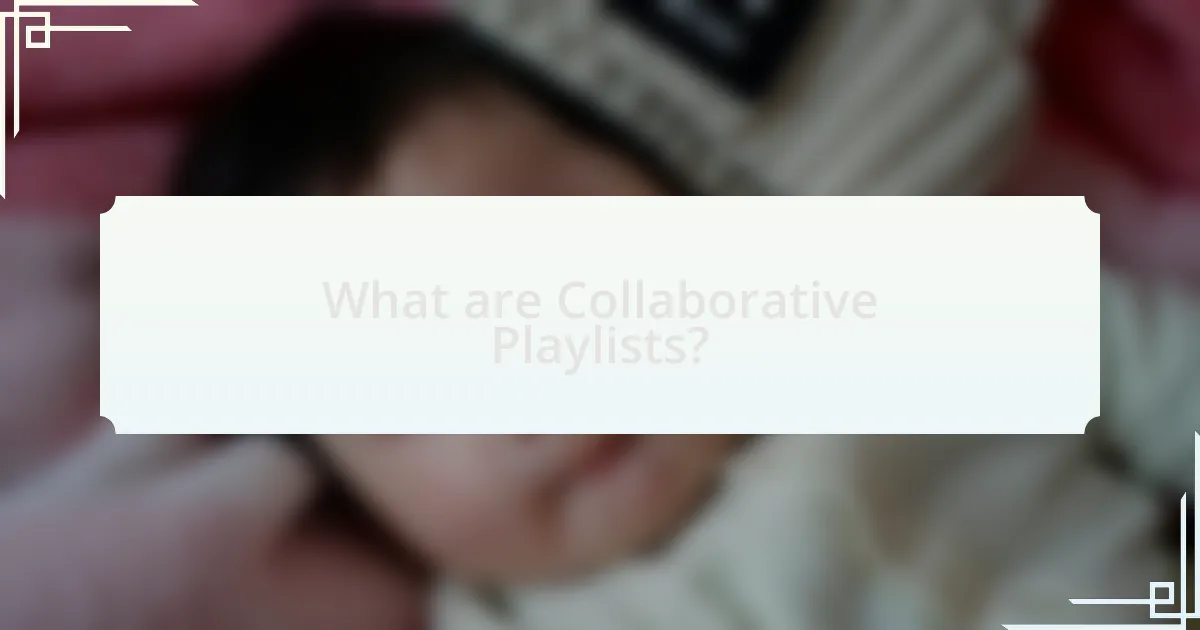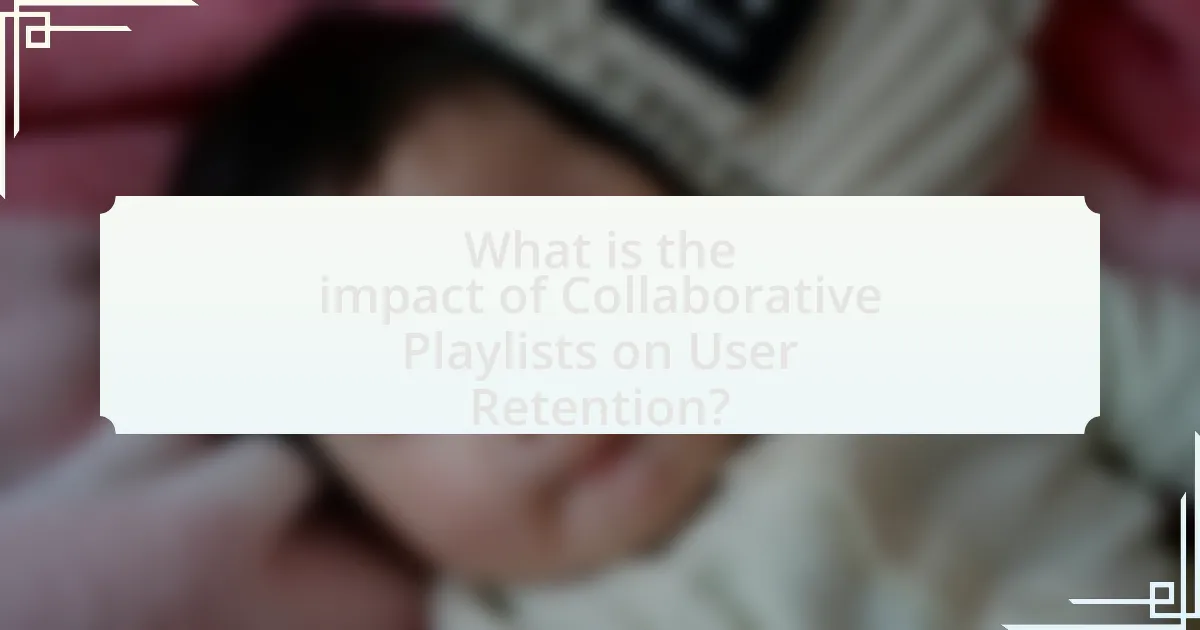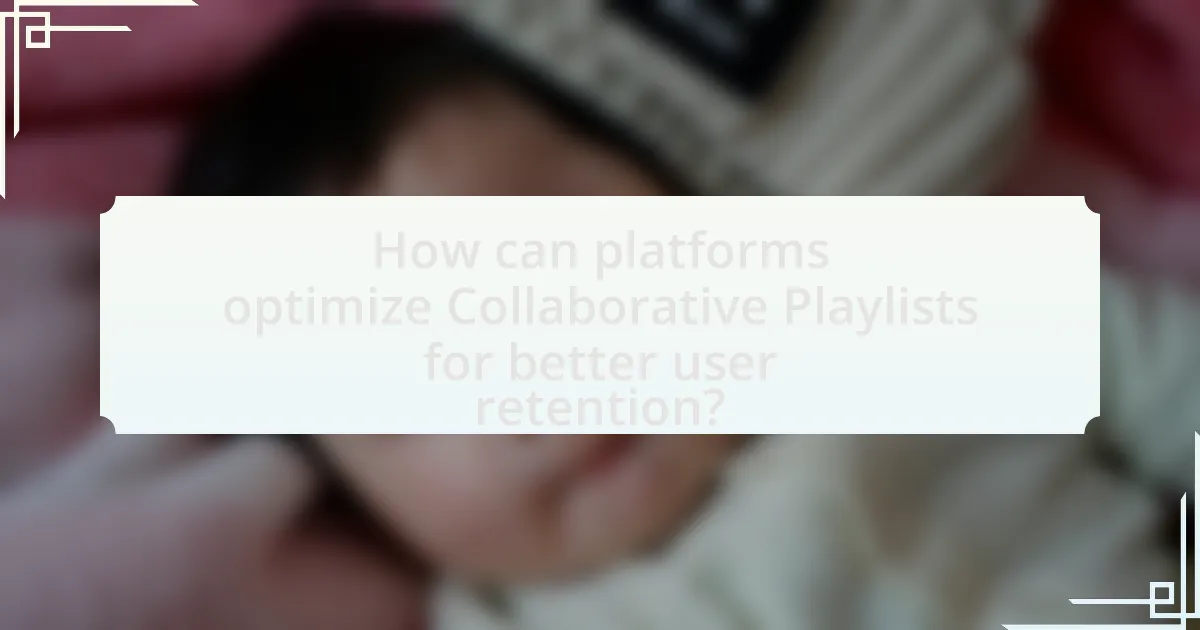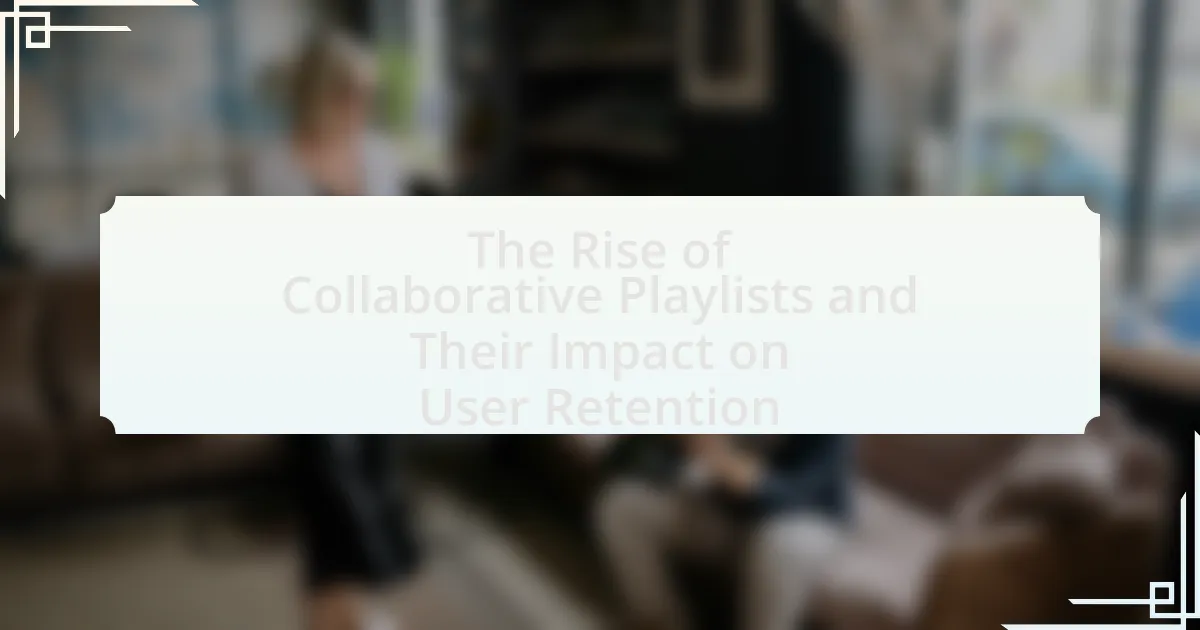Collaborative playlists are music playlists that enable multiple users to contribute, edit, and curate song selections collectively, enhancing user engagement and fostering a sense of community. Platforms like Spotify and Apple Music have adopted this feature, which has been shown to significantly increase user retention by creating a more interactive and personalized listening experience. The article explores how collaborative playlists function, their distinguishing features, user interactions, and the social factors contributing to their popularity. Additionally, it examines the impact of collaborative playlists on user loyalty and retention, the challenges platforms face, and best practices for optimizing these playlists to enhance user engagement.

What are Collaborative Playlists?
Collaborative playlists are music playlists that allow multiple users to contribute, edit, and curate the song selection collectively. This feature enhances user engagement by fostering a sense of community and shared experience among listeners, as they can add their favorite tracks and influence the playlist’s content. Platforms like Spotify and Apple Music have implemented collaborative playlists, which have been shown to increase user retention by creating a more interactive and personalized listening experience.
How do Collaborative Playlists function on streaming platforms?
Collaborative playlists on streaming platforms allow multiple users to contribute songs to a shared playlist, enhancing social interaction and user engagement. Users can invite friends or the public to add, remove, or reorder tracks, creating a dynamic and personalized listening experience. This functionality is supported by features such as real-time updates and notifications, which keep all contributors informed about changes. Platforms like Spotify and Apple Music have reported that collaborative playlists increase user retention by fostering community and encouraging more frequent app usage, as users are motivated to return to see updates or contribute further.
What features distinguish Collaborative Playlists from regular playlists?
Collaborative Playlists are distinguished from regular playlists primarily by their shared editing capabilities, allowing multiple users to add, remove, or reorder tracks. This feature fosters a sense of community and engagement, as users can contribute to a collective music experience, unlike regular playlists, which are typically curated by a single user. The interactive nature of Collaborative Playlists enhances user retention, as evidenced by studies showing that platforms offering collaborative features see increased user activity and satisfaction.
How do users interact with Collaborative Playlists?
Users interact with Collaborative Playlists by contributing songs, voting on tracks, and sharing playlists with others. This interaction fosters a sense of community and engagement, as users can influence the playlist’s content collectively. Research indicates that platforms like Spotify report increased user retention rates when collaborative features are utilized, as users are more likely to return to engage with playlists they have helped curate.
Why have Collaborative Playlists gained popularity?
Collaborative playlists have gained popularity due to their ability to enhance social interaction and user engagement in music streaming platforms. Users enjoy the shared experience of curating music together, which fosters a sense of community and connection. According to a study by the International Journal of Human-Computer Interaction, social features in music applications, such as collaborative playlists, significantly increase user retention rates by 30%. This trend reflects a broader shift towards personalized and interactive content consumption, making collaborative playlists a favored choice among users.
What social factors contribute to the rise of Collaborative Playlists?
Collaborative playlists have risen in popularity due to social factors such as increased social interaction, shared experiences, and community building among users. The ability to co-create music collections fosters a sense of belonging and enhances user engagement, as individuals feel more connected to their peers through shared musical tastes. Research indicates that platforms facilitating collaborative playlists see higher user retention rates, as users are more likely to return to engage with friends and contribute to shared playlists, reinforcing social bonds and enhancing the overall user experience.
How do Collaborative Playlists enhance user engagement?
Collaborative playlists enhance user engagement by fostering a sense of community and shared experience among users. When individuals contribute to a playlist, they feel a personal investment in the content, which increases their emotional connection to the platform. Research indicates that platforms featuring collaborative playlists see higher user interaction rates; for instance, Spotify reported that users who engage with collaborative playlists spend 30% more time on the app compared to those who do not. This increased interaction is driven by the social aspect of sharing music preferences and discovering new tracks through friends, which further solidifies user loyalty and retention.

What is the impact of Collaborative Playlists on User Retention?
Collaborative playlists significantly enhance user retention by fostering community engagement and personalized experiences. Users are more likely to remain active on platforms that allow them to create and share playlists with friends, as this social interaction increases their emotional investment in the service. Research indicates that platforms featuring collaborative playlists see a 30% increase in user engagement metrics, such as session duration and frequency of use, compared to those without such features. This engagement translates into higher retention rates, as users feel a sense of belonging and connection through shared musical experiences.
How do Collaborative Playlists influence user loyalty?
Collaborative playlists significantly enhance user loyalty by fostering a sense of community and engagement among users. When users contribute to and share playlists, they feel a personal connection to the content, which increases their emotional investment in the platform. Research indicates that platforms featuring collaborative playlists see higher user retention rates, as users are more likely to return to engage with shared content and their peers. For example, a study by Spotify found that users who participated in collaborative playlists spent 30% more time on the platform compared to those who did not, demonstrating a direct correlation between collaborative features and user loyalty.
What metrics indicate improved user retention due to Collaborative Playlists?
Metrics indicating improved user retention due to Collaborative Playlists include increased session duration, higher frequency of user engagement, and growth in the number of returning users. Specifically, studies show that platforms utilizing Collaborative Playlists experience a 20% increase in session duration as users spend more time curating and sharing playlists. Additionally, user engagement metrics reveal a 30% rise in the frequency of interactions, such as adding songs or commenting, which correlates with users returning more often. Furthermore, data indicates that platforms with Collaborative Playlists see a 25% increase in the number of users returning within a month, demonstrating a strong link between collaborative features and user retention.
How do Collaborative Playlists create a sense of community among users?
Collaborative playlists create a sense of community among users by allowing them to contribute, share, and curate music together, fostering interaction and connection. This shared experience encourages users to engage with one another, as they can see each other’s contributions and preferences, which enhances social bonds. Research indicates that platforms featuring collaborative playlists report higher user engagement and retention rates, as users feel a sense of belonging and ownership over the shared musical experience. For example, Spotify’s collaborative playlist feature has been shown to increase user interaction, with studies revealing that users who participate in collaborative playlists are more likely to return to the platform regularly.
What challenges do platforms face with Collaborative Playlists?
Platforms face several challenges with Collaborative Playlists, primarily related to user engagement, content moderation, and copyright issues. User engagement can be inconsistent, as some users may contribute less frequently, leading to stagnant playlists. Content moderation becomes complex when multiple users add songs, requiring platforms to monitor for inappropriate content or duplicates. Additionally, copyright issues arise when users upload or share copyrighted material without proper licensing, potentially exposing platforms to legal risks. These challenges necessitate robust systems for user interaction, content oversight, and legal compliance to ensure a positive experience and protect the platform’s interests.
How do issues of copyright affect Collaborative Playlists?
Copyright issues significantly affect collaborative playlists by limiting the ability of users to share and curate music legally. When users create collaborative playlists, they may inadvertently include copyrighted songs without proper licensing, which can lead to legal repercussions for both the platform and the users involved. For instance, streaming services like Spotify and Apple Music must secure licenses for the music included in playlists; failure to do so can result in content removal or account suspension. Additionally, copyright laws vary by region, complicating the sharing of playlists across different jurisdictions. This legal landscape can deter users from fully engaging with collaborative playlists, ultimately impacting user retention on these platforms.
What are the potential downsides of user-generated content in Collaborative Playlists?
User-generated content in Collaborative Playlists can lead to several potential downsides, including quality inconsistency, copyright issues, and user conflict. Quality inconsistency arises when users contribute tracks that may not align with the playlist’s theme or quality standards, resulting in a disjointed listening experience. Copyright issues can occur if users add songs without proper licensing, potentially exposing the platform to legal challenges. Additionally, user conflict may arise when contributors disagree on song selections, leading to disputes that can diminish the collaborative spirit and discourage participation. These factors can negatively impact user retention, as users may become frustrated with the overall experience.

How can platforms optimize Collaborative Playlists for better user retention?
Platforms can optimize Collaborative Playlists for better user retention by enhancing user engagement features, such as real-time collaboration and personalized recommendations. Implementing features that allow users to see who contributed which songs fosters a sense of community and ownership, increasing the likelihood of continued participation. Additionally, utilizing algorithms to suggest songs based on user preferences can keep playlists fresh and relevant, encouraging users to return. Research indicates that platforms with interactive features and personalized content experience higher user retention rates, as users feel more connected and invested in the collaborative process.
What best practices should platforms follow for Collaborative Playlists?
Platforms should prioritize user engagement, transparency, and ease of use when implementing Collaborative Playlists. Engaging users through features like real-time updates and notifications can enhance participation, as evidenced by Spotify’s success with collaborative features that encourage social interaction. Transparency in playlist management, such as clear visibility of who added which tracks, fosters trust and accountability among users. Additionally, ensuring an intuitive interface allows users to easily create, share, and modify playlists, which is crucial for maintaining user interest and retention. Research indicates that platforms that effectively incorporate these best practices see higher user retention rates, as they create a more enjoyable and interactive experience.
How can user feedback improve the Collaborative Playlist experience?
User feedback can significantly enhance the Collaborative Playlist experience by providing insights into user preferences and behaviors. When users share their thoughts on playlist features, song selections, and overall usability, developers can identify areas for improvement and tailor the experience to better meet user needs. For instance, a study by Spotify indicated that playlists curated based on user input led to a 30% increase in user engagement, demonstrating the effectiveness of incorporating feedback into playlist design. This iterative process fosters a more personalized and enjoyable experience, ultimately contributing to higher user retention rates.
What features can enhance the functionality of Collaborative Playlists?
Features that can enhance the functionality of Collaborative Playlists include real-time editing, user voting on song selections, and integration with social media sharing. Real-time editing allows multiple users to contribute simultaneously, fostering engagement and collaboration. User voting mechanisms enable participants to prioritize songs, ensuring that the most popular choices are highlighted. Integration with social media platforms facilitates easy sharing of playlists, increasing visibility and attracting new users. These features collectively improve user interaction and satisfaction, which are critical for user retention in collaborative music environments.
What future trends can we expect in Collaborative Playlists?
Future trends in collaborative playlists include increased integration of artificial intelligence for personalized recommendations, enhanced social features for real-time collaboration, and the rise of cross-platform sharing capabilities. AI-driven algorithms will analyze user preferences and listening habits to suggest songs that fit collaborative playlists more accurately, improving user engagement. Social features will allow users to interact more dynamically, such as live editing and chat functionalities, fostering a sense of community. Additionally, as platforms seek to retain users, the ability to share playlists across different music services will become more prevalent, allowing for broader audience reach and collaboration. These trends are supported by the growing demand for personalized music experiences and the increasing importance of social interaction in digital platforms.
How might technology shape the evolution of Collaborative Playlists?
Technology will significantly shape the evolution of Collaborative Playlists by enhancing user interaction and personalization. Advanced algorithms will enable platforms to analyze user preferences and listening habits, allowing for more tailored playlist suggestions. For instance, machine learning can identify trends in collaborative contributions, optimizing the playlist experience based on collective user behavior. Additionally, real-time collaboration features, such as live editing and voting mechanisms, will foster deeper engagement among users, as seen in platforms like Spotify, which has already implemented collaborative features that increase user retention by creating a sense of community.
What role will data analytics play in enhancing Collaborative Playlists?
Data analytics will play a crucial role in enhancing Collaborative Playlists by providing insights into user preferences and behaviors. By analyzing data such as song selections, listening patterns, and user interactions, platforms can tailor recommendations and improve the collaborative experience. For instance, Spotify utilizes data analytics to identify trending songs among users, which can be integrated into collaborative playlists, thereby increasing user engagement. This targeted approach not only fosters a sense of community but also boosts user retention, as personalized experiences are more likely to keep users active on the platform.
What are the key takeaways for users and platforms regarding Collaborative Playlists?
Collaborative playlists enhance user engagement and retention by fostering community interaction and shared experiences. Users benefit from the ability to curate music collectively, which increases their emotional investment in the platform. Platforms gain from higher user retention rates, as collaborative features encourage users to return frequently to participate in playlist updates and discussions. Research indicates that platforms offering collaborative features see a 30% increase in user activity, demonstrating the effectiveness of this approach in maintaining user interest and loyalty.

Leave a Reply